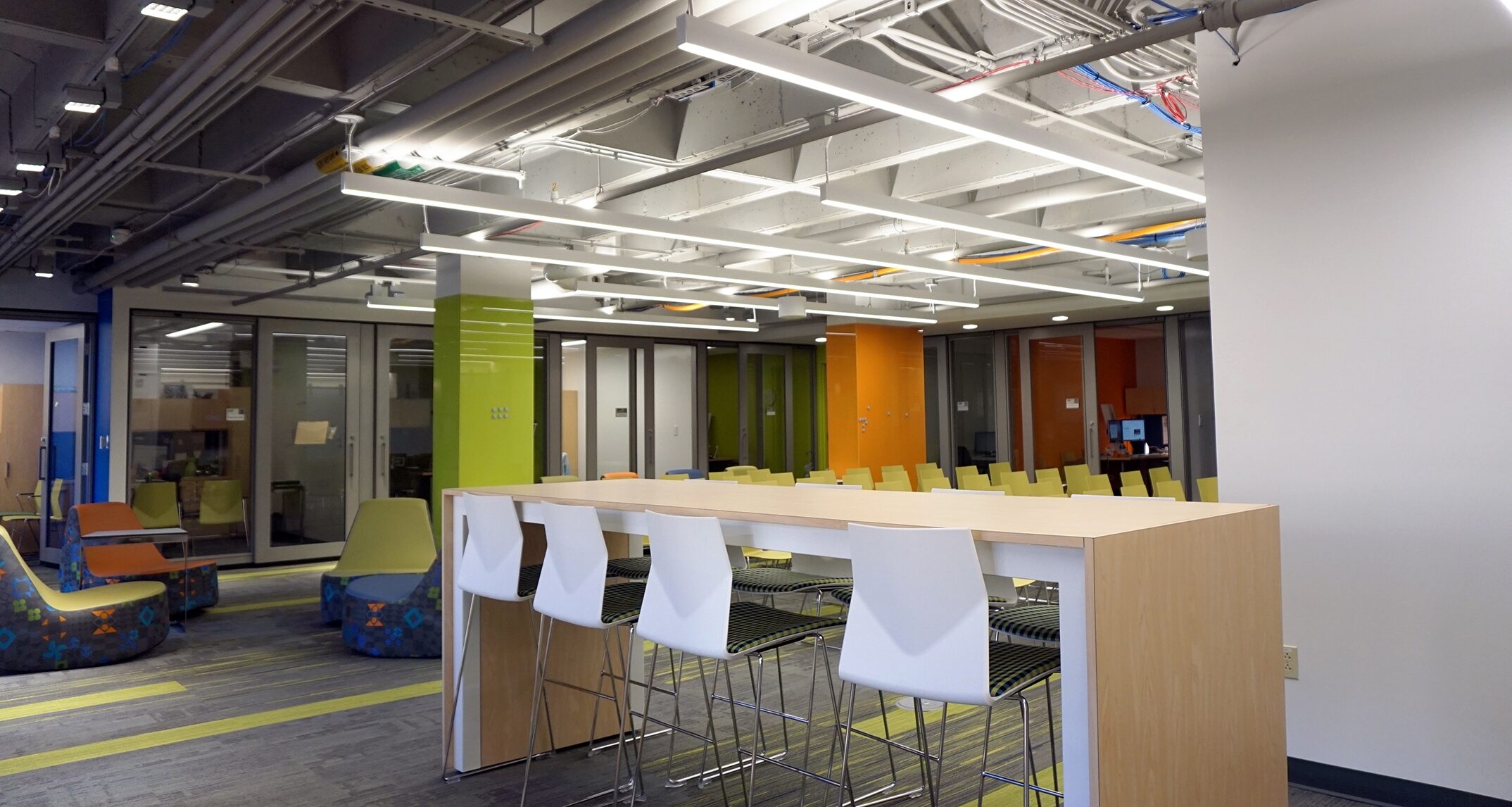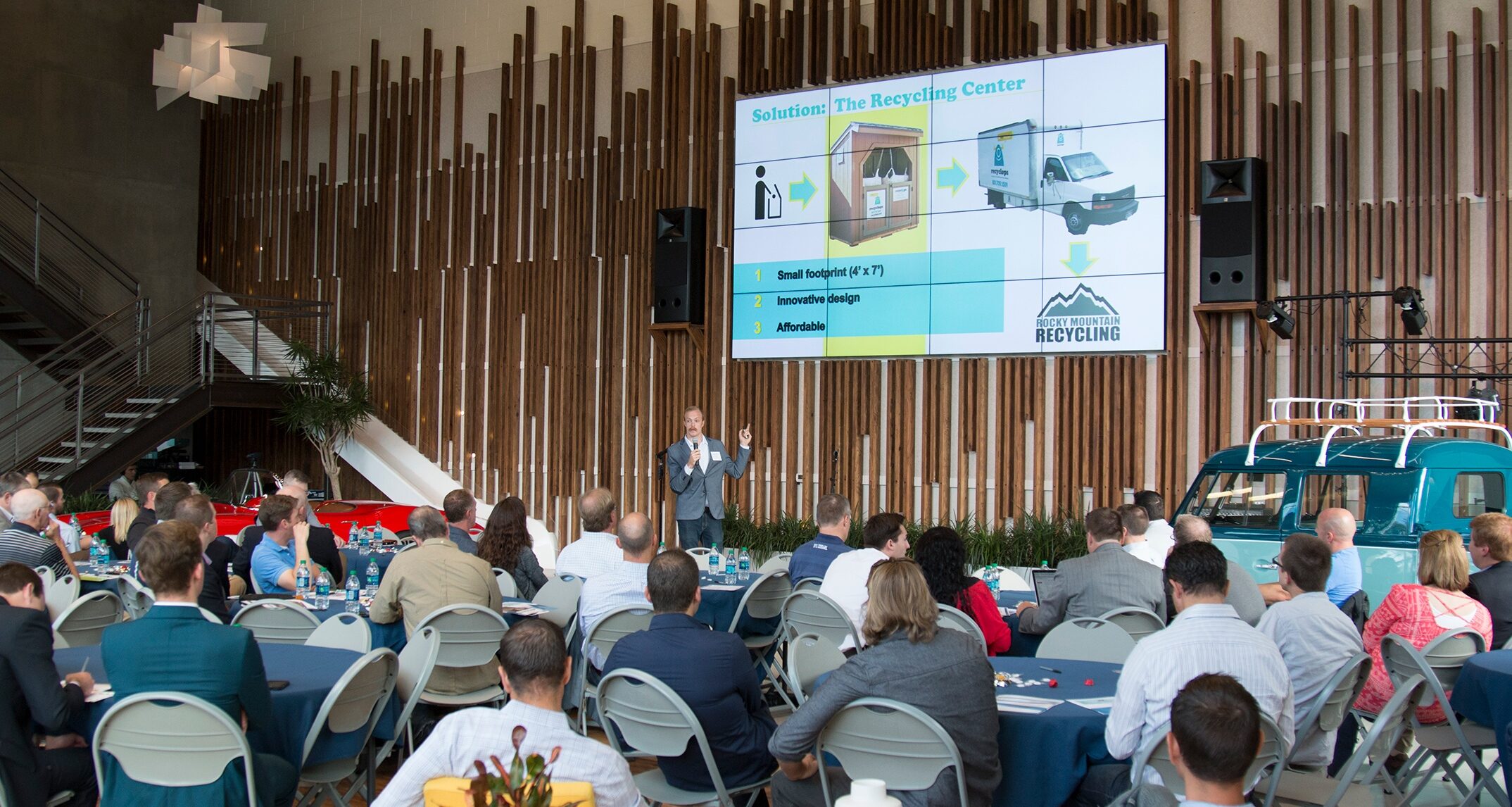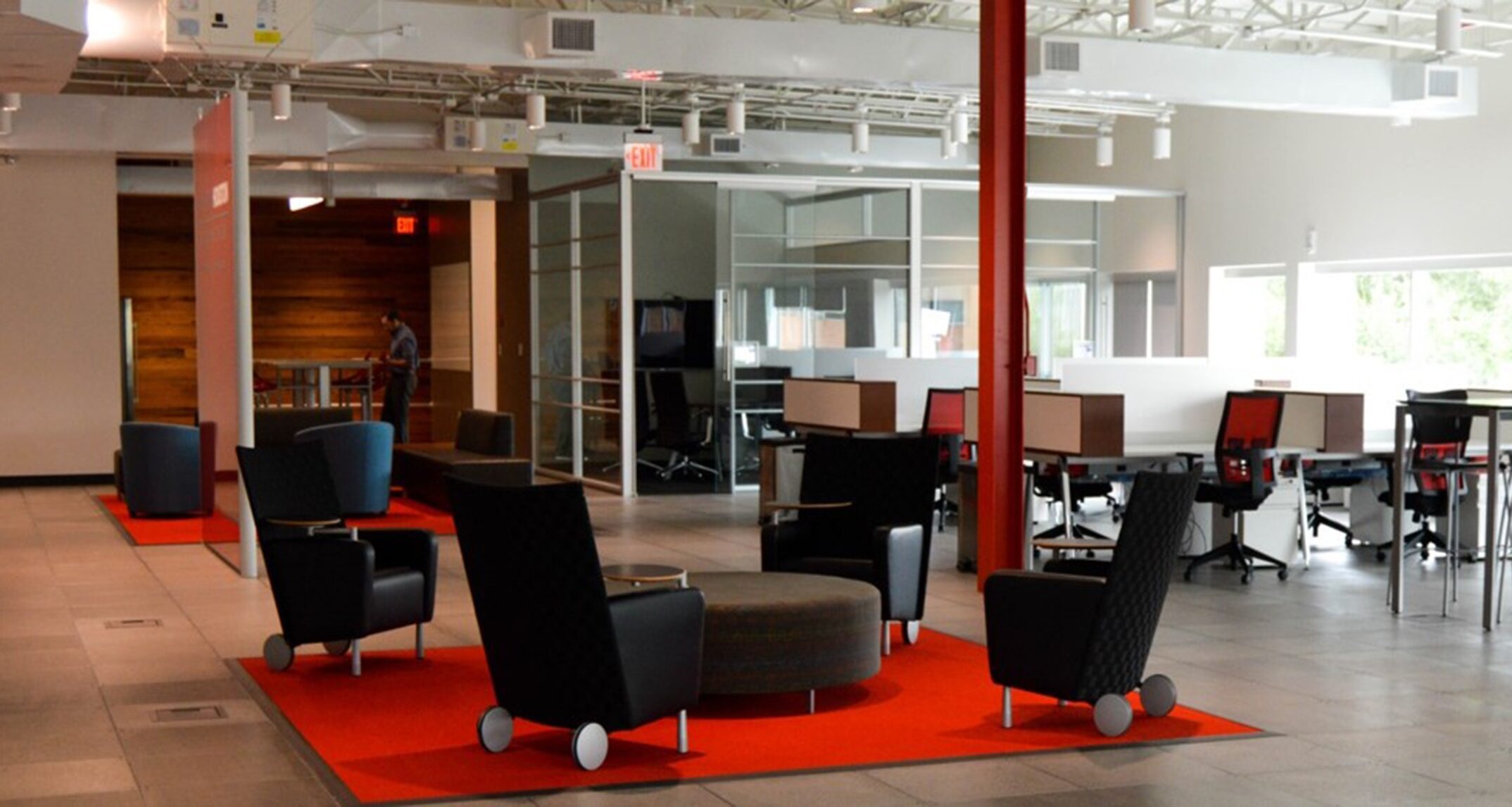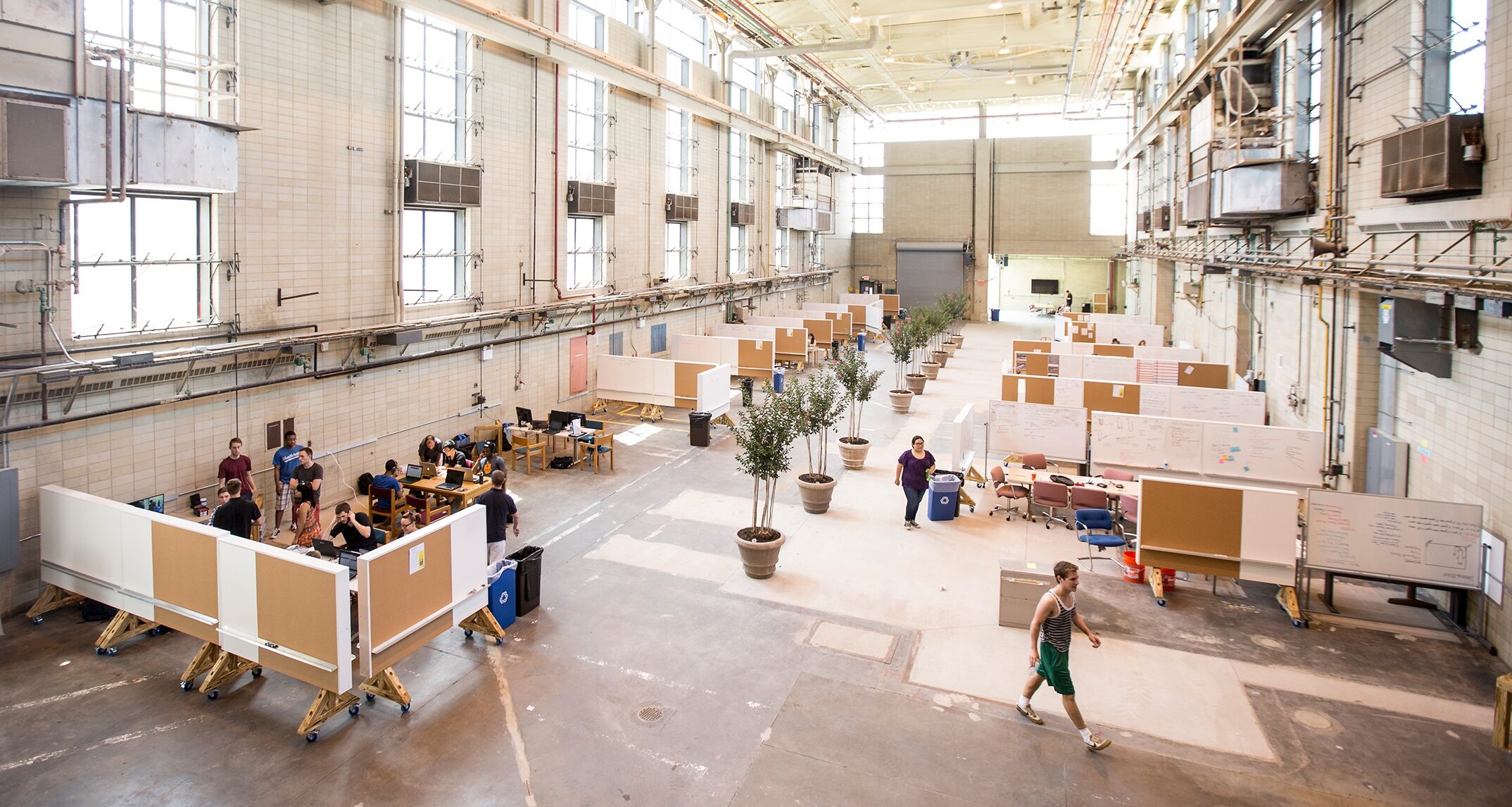Entrepreneur Centers on College Campuses: Fad or Necessity?

Entrepreneurship and innovation are increasingly popular topics of conversation among higher education officials across the country. Over the last decade, countless higher education institutions have embraced innovation and entrepreneurship as critical to their institutional mission.
Turns out, these programs are incredible vehicles for transforming the undergraduate academic experience. Arguably, these programs in conjunction with a traditional course of study, are better preparing students for their working lives. Moreover, a number of colleges and universities are discovering the value-added by taking the architecture studio concept and opening it up to a variety of disciplines. The focus is swiftly becoming the space, and what it can bring out in people – breaking down historical silos and creating new partnerships.

Washington University in St. Louis Skandalaris Center for Interdisciplinary Innovation
Why build an entrepreneurship center on campus?
NAC had the opportunity to talk with individuals from colleges and universities across the country that are involved with successful entrepreneurship programs. Through these conversations, we found that there are three main drivers for having these centers on campus:
1. Entrepreneurship programs develop in students the skills and mindsets they need for successful lives as scholars and citizens. It’s hard to predict what students will see when they enter the workforce and over their lifetime. Consequently, we need to focus our attention on updating the undergraduate academic experience to adequately prepare our students for anything. That means focusing on experiential learning opportunities, adaptive learning skills, and systems thinking, all of which are inherent to entrepreneurial learning experiences (which are grounded in theories of design thinking, lean startup and agile development).
Emre Toker, Managing Director of the Skandalaris Center for Interdisciplinary Innovation and Entrepreneurship at Washington University in St. Louis, describes the usefulness of an entrepreneurship curriculum. “Entrepreneurship is a great vehicle for preparing our students to succeed in an innovative environment. Through entrepreneurship, students must test their limits because, as you know, entrepreneurship requires you to test your analytical intelligence as well as your creative, social, and practical intelligence.”
Skills commonly developed through an entrepreneurial project include: comfort with ambiguity, ability to find and solve complex problems, empathy for others, and grit
2. Entrepreneurship programs and centers are a great means for translating science into impact. Strong entrepreneurial programs at universities help accelerate the transition of research innovations, seamlessly moving from the lab to the marketplace. Furthermore, advances in a variety of fields are making clear the value of applying discoveries and approaches as widely as possible. Oftentimes government agencies can slow the development of interdisciplinary advances since they solicit grant proposals in field-specific categories. Entrepreneurship centers that co-locate faculty with industry professionals may be able to circumvent these roadblocks.
3. Entrepreneurship centers create opportunities for universities to play a role in the economic and social development of their local community. Over one-third of the 1,250 business incubators in the United States are at a college or university . Through industry partnerships, universities are finding new ways to contribute long-term societal benefits. These partnerships often result in the novel application of scientific discoveries, translating research results into practical knowledge and technological innovations.

Brigham Young University Center for Entrepreneurship and Technology
What Space Can Do For You
Research supporting the nonverbal communications link between the physical environment and behavior is well established; spaces send signals to people reminding them which behaviors are accepted and which are not. Intentionally designed spaces are able to elicit certain behaviors from people, in turn fostering particular experiences. The right space can positively punctuate the equilibrium of a project or team, creating a shift in thinking.
Entrepreneurship centers are adept at:
- Sparking conversations, putting the focus on process rather than product.
- Encouraging the exchange of ideas across disciplines.
- Mimicking some of the careers students will pursue after graduation.
- Attracting outside businesses and investors, creating unique and opportune partnerships with faculty and students.
- Accelerating the transition of research to the marketplace.
So what’s common to these settings that enable them to achieve these results over and over again?

University of Houston Wolff Center for Entrepreneurship
Lessons Learned: Facility Design
While there is no singular formula for what these spaces look like, these lessons learned from some of the top programs in the country can help direct facility design:
To promote inclusivity …
At many universities the entrepreneurship center is part of the business school
or engineering school. But some institutions, like Washington University in St.
Louis, have found that a standalone center makes it more appealing to all
students.
Emre Toker explains, “At Washington we’re different – we are interdisciplinary.
We are after bringing the dance student and the anthropology student into the
funnel in addition to the business students. This requires the center to be
perceived as an entity that is outside the business and engineering schools.
Our facility is located in a central part of the campus near the student
center. Furthermore, we positioned Skandalaris not just as an entrepreneurship
center, but a gathering place for creative people.”
For those programs that are housed in a particular school (e.g., the school of
engineering), physical proximity can be an issue.
Steven Fox, Managing Director of the Center for Entrepreneurship and Technology
at Brigham Young University recounts, “We occupy a space in the business school
but we serve as a resource across the campus (for students of any major). We
wish we had our own standalone physical entity on campus to show that we are a
hub and available to all students equally. Because we’re housed in the business
school, students who don’t know us well think we just serve business school
students. The lack of a unique physical space on campus is something we have to
overcome on a daily basis.”
To promote teamwork …
Despite cultural pressures to design an open warehouse-type space, our experts
find that a cavernous hall doesn’t always work that well. Fox went on to say,
“There’s this idea that open space (for example Facebook and Google) is the way
to go. My view is that you need to have some unique space that a small team
owns and can be cut off from the distractions of others, and then open up into
a wide open space. It’s tough to have phone calls with potential suppliers with
people walking in and out of your space; there’s a lot of distraction. You
don’t want to lock them up, they need to be able to interact with others, but
they need space they can own.”
Teams struggle when they don’t have a unique space unto themselves. It can be
hard for multiple teams to work concurrently in a warehouse-type space which
tends to create a cacophony of sounds; this is often distracting and hard on
team dynamics. However, large warehouse-type spaces aren’t all bad—they offer
benefits in proximity (co-locating with other companies or teams that may not
otherwise interact). That’s why successful models are adept at blending the
two—having a large, open co-locating space that teams can spill out into
combined with smaller dynamic rooms teams can “own” for the duration of a
project or quarter.

Lehigh University Baker Institute for Entrepreneurship - Christa Neu
To promote productive failure ...
Honda’s founder, Sochiro Honda, once said, “Success is 99% failure.” A crucial
part of innovation is learning from this failure. Making mistakes allows for
variations and ideas to be uncovered that are beyond what is expected, which
can ultimately lead to developing the winning idea, product, or design. Because
of this, entrepreneurship centers need to give students the confidence to dive
into a project, test an idea, and often times try it again. Ken Jones, Director
of the Wolff Center for Entrepreneurship at the University of Houston, talks
about the need to give students an environment where they feel safe to take
risks. “You have to maintain privacy. A lot of folks don’t like to speak
publicly on the telephone or have their peer group realize what they don’t
know.”
At the same time, these spaces must support independent exploration of ideas,
and provide the tools necessary for students to collaborate with their peers.
Educators in these environments should be there to guide and support students,
but give them the freedom to make productive mistakes. The Skandalaris Center
at Washington University is set up just this way. “Our place [at Washington
University] is an open co-working space that is configurable to any situation
that the students want to build,” said Toker. “Everything is portable - tables,
chairs, etc. All the walls are writable. Everything we do is geared towards our
ability to pull the students into a creative space, a central location. We have
all of our support people on the periphery of the center so that we’re
nonintrusive—we’re just waiting to provide support to the students when
needed.”
To stay ahead of the curve …
Staying at the forefront of emerging products and trends is a requirement for
successful enterprise. New tactics and strategies can cause teams to reexamine
their methods and systems. A deal from a supplier or an increase in funding may
lead to additional features. Because of this, entrepreneurship spaces must be
designed to accommodate frequent, sometimes rapid changes in project thinking
and execution. When describing features that make the Wolff Center a success,
Ken Jones said, “Flexibility—what was good for you last month might have to be
redesigned this month depending on how many firms you have.”
From academia’s perspective, it is clear to see that the tenets of entrepreneurship programs are key to updating the undergraduate academic experience. From interdisciplinary problem solving to creating partnerships with outside businesses and investors, entrepreneurship centers prepare students for life after graduation.
Thank You to Our Interviewees!
Steven Fox Lisa Getzler-Linn
Managing Director
Center for Entrepreneurship and Technology
Brigham Young University
Executive Director
Baker Institute for Entrepreneurship, Creativity
Innovation at Lehigh University
Kenneth Jones Emre Toker
Director
Wolff Center for Entrepreneurship
University of Houston
Managing Director
Skandalaris Center for Interdisciplinary Innovation and Entrepreneurship
Washington University in St. Louis
